1948 Hebrew IDF Advertisement MILITARY POSTER Israel INDEPENDENCE Cigarette HAT
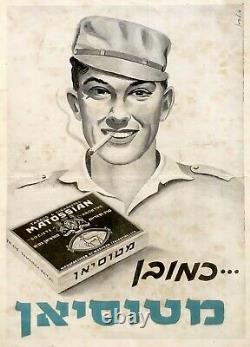
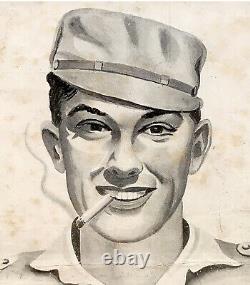
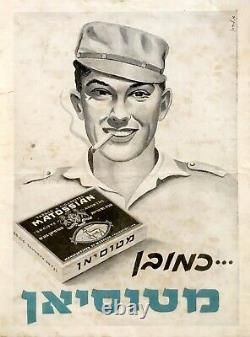

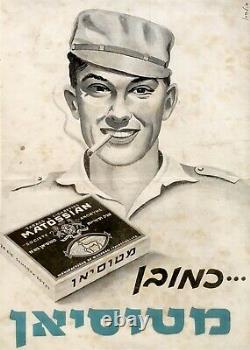
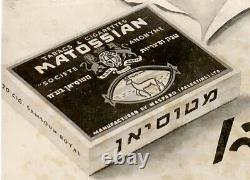



Here for sale is an ORIGINAL, Over 70 years old illustrated FULL PAGE poster-like large colored ADVERTISEMENT which was attached to the 1948 (Fully dated), No. 2 issue of the MILITARY WEEKLY MAGAZINE of the ISRAELI DEFENSE FORCE - IDF - ZAHAL. It was published in ERETZ ISRAEL (Then also refered to as Palestine) RIGHT after the establishment of the INDEPENDENT STATE of ISRAEL and the midst of its 1948 WAR of INDEPENDENCE.
The ADVERTISEMENT depicts a smiling ISRAELI SOLDIER, Wearing the typical 1948 MILITARY HAT - The "HITELMACHER" , Advertising one of the most POPULAR and KNOWN cigarettes type "MATOSSIAN" of "MASPERO". The illustrated CIGARETTE BOX is still marked as "PALESTINE". With its exceptional FULL PAGE SIZE, The typical 1948 graphic design (Made by LEHMANN), The wide white frame, and the EXCEPTIONAL HISTORICAL DATE of ISSUE, This UNIQUE advertisement has a POSTER QUALITY and it definitely deserves framing. The poster-like ADVERTISEMENT was removed from the No. 2 issue of the military magazine " BAMACHANE" (In CAMP). The front page of the magazine is printed on its back. (Pls look at scan for accurate AS IS images). Ill be sent FLAT in a special protective rigid sealed package. AUTHENTICITY : The ADVERTISEMENT-POSTER is fully guaranteed ORIGINAL from 1948, It is NOT a reproduction or a recently made reprint or an immitation, It holds a life long GUARANTEE for its AUTHENTICITY and ORIGINALITY. W ill be sent in a special protective rigid sealed package. Israeli Army'Hitelmacher' Hat: Though the Israeli Army earned glory on the battlefield in 1948, it came into being during a period where militaria started to lose its national uniqueness. Under the influence of Eastern and Western alliances, and more efficient production processes, armies began to adopt homogenous, if boring, accessories and equipment such as mass-made nylon patches, conventional uniforms and plain, generic helmets. During the 1947-49 War of Independence, the Israeli Defence Forces (IDF) and its forerunners sported'sock hats' ("Kova Gerev" - in Hebrew) from local manufacture or leftover British Army stocks. However the army also succeeded in receiving a uniquely styled hat in sufficient quantities that its presence also left its mark on the identity of the army: the'Hitelmacher' hat.The Hitelmacher bears a semblance to a kepi in the style of a Finnmark hat, but when affixed with the Army's emblem, it also exhibits a ceremonial elegance. Available information on the hat's origins is difficult to locate, however from what is known, in 1947 the Transitional Government in the Jewish areas of Palestine placed orders for hats with manufacturers in New York.
The original style which was subsequently produced and supplied was made by a firm bearing the Yiddish word for'hat-maker' - "Hitelmacher" - and hats of this style then and since have come to be known here as "Hitelmacher" hats. These kinds of hats were originally produced in the United States, and later in Israel.
Their uniqueness is in their practicality, quality of manufacture and style: a straight-sided round hat with a firm visor, leather chin strap and sweat bands and drop down cloth back to protect the wearer's neck, all held together with strong stitching. In light of the lack of available information on styles and appearances I can only rely on photographic examples and experience: there existed at least two widely distributed color varieties of these hats - one with khaki denim and a black leather chin-strap, with stitch lines on the visor (the American variety), and a light-green denim version with a green leather chin-strap and plain denim visor (the version here; an Israeli make). Other varieties are also likely as photographs illustrate types with thicker, firmer fabric or others with both fabric and chin-straps in khaki.
So far, I have not found any consistency as to the wearing of these styles (or of variations in their accoutrements). Although the IDF wore light-green caps of various types through to the 2000's, photographs suggest that the Hitelmacher hat was worn up until around the 1956 Sinai Campaign ("Operation Kadesh").
The example shown here seems to be from the early to mid-1950's: inside it is stamped with the Hebrew letter "Tet" and the number "55" (although the standard stamp bearing the IDF's first initial "Tz" - for "Tzahal" - is not present). The "Tet" is probably the hat size, and the "55" may correspond to the date of issue - 1955. In spite of its simple appearance, the hat is full of interesting details. The deteriorating maker's label inside indicates that it was made on Nachlat Binyamin Street in Tel Aviv - an Israeli manufacture. An interesting detail is the plain green un-maker marked buttons holding down the chin-strap on each side. Buttons on Israeli military hats in the early 1950's, but also in the late'40s, also bore the embossed emblem of the IDF - with and without maker-marks, and a photograph of the second Israeli Chief of the General Staff, Yigal Yadin, from around 1948 shows his Hitelmacher hat bearing those such buttons.Therefore it's curious to see a possibly late-dated hat without decorated buttons. The leather chin-strap's'knots' are held in place by two metal staples. On the inside, the buttons which fasten the strap are themselves held in place by an inch-long thin, light orange plastic pin.
Unlike on other visored hats, the four air holes on the Hitelmacher are formed from tightly stitched circles and not from the insertion of a plastic framed loop. Another interesting detail is the metal fastening hook on each corner of the drop-down cloth sides: this hat has black colored hooks; other versions of this green styled hat sport silver colored hooks. These hooks would latch onto the first air-hole at the front of the hat in order to hold the flaps in place. This hat also has green elastic bands on the bottom ends of the drop down sides (which would be wrapped over the buttons to keep the sides up); other versions of this hat have creme-colored bands instead. The Israel Defense Forces (IDF) Hebrew:?????Tzva HaHagana LeYisra'el (help·info), lit. Defense Army for Israel, commonly known in Israel by the Hebrew acronym Tzahal?? , are Israel's military forces, comprising the ground forces, air force and navy. It is the sole military wing of the Israeli security forces, and has no civilian jurisdiction within Israel. The IDF is headed by its Chief of General Staff, the Ramatkal, subordinate to the Defense Minister of Israel; the current Chief of Staff, since 2007, is Lieutenant General Gabi Ashkenazi.
At the order of Defense Minister David Ben-Gurion on May 26, 1948, the Israel Defense Forces were officially formed as a conscript army out of the paramilitary group Haganah, incorporating the militant groups Irgun and Lehi. It served as Israel's armed forces in all the country's major military operations - including the 1948 Arab-Israeli War, the 1956 Sinai War, the 1967 Six-Day War, the War of Attrition, the 1973 Yom Kippur War, Operation Litani, the 1982 Lebanon War, Operation Defensive Wall, the 2006 Lebanon War and Operation Cast Lead. While originally the IDF was operational on three fronts-against Lebanon and Syria in the north, Jordan and Iraq in the east, and Egypt in the south-after the 1979 Egyptian-Israeli Peace Treaty, its activities have mainly been concentrated in southern Lebanon and the Palestinian Territories, including the First and the Second Intifada. The Israel Defense Forces differs from most armed forces in the world in many ways, including the conscription of women, and the structure, with close relations between the ground forces, air force and navy. Since its founding, the IDF has striven to be a unique army fitting Israel's specific requirements. In 1965, the Israel Defense Forces was awarded the Israel Prize for its contribution to education. [3] The IDF uses several technologies developed in Israel, many of them made specifically to match the IDF's needs, such as the Merkava main battle tank, advanced Hi-Tech weapons systems, and the Galil and Tavor assault rifles. The Uzi submachine gun was used by the IDF until December 2003, ending a service that began in 1954. The IDF also has close military relations with the United States, [4] including development cooperation, such as on the F-15I jet, THEL laser defense system, and the Arrow missile defense system.History Main articles: History of the Israel Defense Forces and Military operations conducted by the Israeli Defense Forces The IDF traces its roots to Jewish paramilitary organizations in the New Yishuv, starting with the Second Aliyah. The first such organization was Bar-Giora, founded in September 1907. It was converted to Hashomer in April 1909, which operated until the British Mandate of Palestine came into being in 1920. Hashomer was an elitist organization with narrow scope, and was mainly created to protect against criminal gangs seeking to steal property.
During World War I the forerunners of the Haganah/IDF were the Zion Mule Corps and the Jewish Legion. After the Arab riots against Jews in April 1920, the Yishuv's leadership saw the need to create a nationwide underground defense organization, and the Haganah was founded in June of the same year. During World War II the successor to the Jewish Legion of World War I was the Jewish Brigade.
The IDF was founded following the establishment of the State of Israel, after Defense Minister and Prime Minister David Ben-Gurion published the order for its creation on May 26, 1948. The order called for the establishment of the Israel Defense Forces, and the abolishment of all other Jewish armed forces. Although Ben-Gurion had no legal authority to issue such an order, the order was made legal by the cabinet on May 31. This was the background for the dispute which led to the Altalena Affair, when following a confrontation regarding the weapons it brought resulted in a battle between Irgun members the newly-created IDF.
Following the affair, all independent Irgun and Lehi units were either disbanded or merged into the IDF. The Palmach, a strong lobby within the Haganah, also joined the IDF with provisions, and Ben Gurion responded by disbanding its staff in 1949, after which many senior Palmach officers retired, notably its first commander, Yitzhak Sadeh. The new army organized itself during the 1948 Arab-Israeli War, when Syria, Lebanon, Egypt, Transjordan, Iraq, Saudi Arabia and Yemen declared war on Israel. Twelve infantry and armored brigades were created: Golani, Carmeli, Alexandroni, Kiryati, Givati, Etzioni, the 7th and 8th armored brigades, Oded, Harel, Yiftach and Negev.
[6] After the war, some of the brigades were converted to reserve units, and others were disbanded. Directorates and corps were created from corps and services in the Haganah, and this basic structure in the IDF still exists today.
Immediately after the 1948 war, the Israel Defense Forces shifted to low intensity conflict against Arab Palestinian guerrillas. In the 1967 Six-Day War, Israel captured the Sinai Peninsula, West Bank and Golan Heights from the surrounding Arab states, changing the balance of power in the region as well as the role of the IDF. In the following years leading up to the Yom Kippur War, the IDF fought a war of attrition against Egypt in the Sinai and a border war against the PLO in Jordan, culminating in the Battle of Karameh. The surprise of the Yom Kippur War and its aftermath completely changed the IDF's procedures and approach to warfare.
Organizational changes were made and more time was dedicated to training for conventional warfare. However, in the following years the army's role slowly shifted again to low-intensity conflict, urban warfare and counter-terrorism. It was involved in the Lebanese Civil War, initiating Operation Litani and later the 1982 Lebanon War, where the IDF ousted Palestinian guerilla organizations from Lebanon.
Palestinian militancy has been the main focus of the IDF ever since, especially during the First and Second Intifadas, Operation Defensive Shield and the Gaza War, causing the IDF to change many of its values and publish the IDF Spirit. The Shia organization Hezbollah has also been a growing threat, against which the IDF fought a full-scale war in 2006. Etymology The name Israel Defense Forces Hebrew:????? Tzva HaHagana LeYisra'el, literally "The Defense Army for Israel" was ratified by the Israeli cabinet on May 26, 1948, the day that the order for the army's founding was published by David Ben-Gurion. The main suggested alternative was Israeli Army/Army of Israel Hebrew:????? Tzva Yisra'el, while others included Jewish Army and Army of the State.The name was chosen for two reasons: because it emphasized that army's role was for defense only, and because it incorporated the name Haganah, the paramilitary organization it was based on. [7] At least three people claim to have coined the name. The Defense Ministry CEO at the time, David Izre'eli, wrote that he suggested it to Levi Eshkol, who forwarded the suggestion to the cabinet. The Chief of Staff Ya'akov Dori, while not claiming to have personally coined the name, said that it was prevalent among senior army personnel and therefore the only natural name.
Ben-Gurion was the third, quoted as saying I gave the name. The name was'Israel Defense Forces'. Among the primary opponents of the name were Minister Haim-Moshe Shapira and the Hatzohar party, both suggesting the name Israeli Army. [7] Organization All branches of the IDF are subordinate to a single General Staff. The Chief of the General Staff is the only serving officer having the rank of Lieutenant General (Rav Aluf).
He reports directly to the Defense Minister and indirectly to the Prime Minister of Israel and the cabinet. Chiefs of Staff are formally appointed by the cabinet, based on the Defense Minister's recommendation, for three years, but the government can vote to extend their service to four (and in rare occasions even five) years. The current chief of staff is Gabi Ashkenazi. He replaced Dan Halutz, who resigned from the IDF following the 2006 Lebanon War. The Israeli Declaration of Independence Hebrew:?????
Hakhrazat HaAtzma'ut or Hebrew:????? Independence Day, the timing of which is based on the Hebrew calendar date of the declaration (5, Iyar, 5708). Palestinias commemorate the event as Nakba Day Arabic:??? Catastrophe Day on 15 May every year. The General Assembly of the United Nations had resolved that'No discrimination of any kind shall be made between the inhabitants on the ground of race, religion, language or sex.And that a declaration to that effect would be made to the United Nations by the Provisional Government of each proposed State before independence. The General Assembly resolution mandated that the stipulations contained in the Declaration were to be non-derogable, they were to be'recognized as fundamental laws of the State and no law, regulation or official action shall conflict or interfere with these stipulations, nor shall any law, regulation or official action prevail over them. The Declaration did promise that the State of Israel would ensure complete equality of social and political rights to all its inhabitants irrespective of religion, race or sex, and guaranteed freedom of religion, conscience, language, education and culture. However, the Knesset maintains that declaration is neither a law nor an ordinary legal document. The Supreme Court of Israel has ruled that the guarantees were merely guiding principles, and that the Declaration is not a constitutional law making a practical ruling on the upholding or nullification of various ordinances and statutes.
Whenever an explicit statutory measure of the Knesset leaves no room for doubt, it is honored even if inconsistent with the principles in the Declaration of Independence. While the possibility of a Jewish homeland in Palestine had been a goal of Zionist organisations since the late 19th century, it was not until 1917 and the Balfour declaration that the idea gained the official backing of a major power. The declaration stated that the British government supported the creation of a national home for the Jewish people in Palestine. The result was Resolution 181, a partition plan to divide Palestine between Jews and Arabs.The Jewish state was to receive around 56% of the land area of Mandate Palestine, encompassing 82% of the Jewish population, though it would be separated from Jerusalem, designated as an area to be administered by the UN. The plan was accepted by most of the Jewish population, but rejected by much of the Arab populace. On 29 November 1947, the plan was put to a vote in the United Nations General Assembly The result was 33 to 13 in favour of the plan, with 10 abstentions. The Arab countries (all of which had opposed the plan) proposed to query the International Court of Justice on the competence of the General Assembly to partition a country against the wishes of the majority of its inhabitants, but were again defeated. The division was to take effect on the date of British withdrawal from the territory (15 May 1948), though the UK refused to implement the plan, arguing it was unacceptable to both sides.
(in 1911 till 1914 was a packing cigarette warehouse, under the Turkish occupation). Tel Aviv - still manufacture after 1948 till 13th. 1956 when went on voluntary liquidation - Emir, Maspero 18, Latif, Matossian Royal, Superfine, Universal, Jasmin, Nacshon, Leumi, Shofra, Zabra, Dalia, Nimrod.
The company produces, markets and distributes cigarettes, cigars, lighters and smoking accessories. Dubek was established in 1935 by Martin Gehl, a German emigrant with a Zionist vision of establishing a manufacturing base in Israel. Throughout the years, Martin Gehl together with his son Zorach, expanded the business and took over all other cigarette manufacturers in Israel.
Leaving Dubek as the only company in the field. In 2003 Dubek became a private company.
Today the company is headed by Dr. Roy Gehl, Martin Gehl's grandson and its main offices are situated in Martin Gehl Street named after its founder. The brand, launched in 1952 in a distinct green, 80mm,'soft-pack' which has never been dramatically changed, is the oldest in Dubek's product line. The cigarette also has the highest tar (19mg) and nicotine (1.3mg) amounts available on the Israeli mass-market. Dubek has since released two different versions under the same Noblesse brand; a lower nicotine/tar blend in light-green packaging (Noblesse Blend - it is illegal to use the term'lite' on cigarettes in Israel[1]), and an even lower nicotine/tar blend in blue packaging (Noblesse American Blue).In addition, the Company also imports its brands to a number of countries overseas. Company brands include Time, Noblesse, no. 9, Mustang, Europe, Nelson, Sheraton, Montana and Broadway. In addition to the brands manufactured in the Company's factory, the Company exclusively imports brands manufactured by the Danish company House of Prince: Wall Street, Rockets and Slim Agenda. Dubek employs maximal efforts to provide its clients a large variety of high-quality products, while maintaining constant innovation and offering a solution to the entire Israeli population, for all its sectors.
The Company's brands enjoy an international reputation of excellence and have won many gold medals for quality in the prestigious international competition "Monde Selection". In 1935 the Company was established by a group of Industrialists, including a mechanical engineer who specialized in equipment for the tobacco industry - Mr.
Since its establishment, the Company has been persistent in manufacturing high quality cigarette products. Gehl, fourth generation of cigarette manufacturers, Dubek became a modern and efficient factory in the Israeli industry. In 1985 Dubek was ranked 11th on the Dun & Bradstreet list of "The 100 leading companies in Israeli Entrepreneurship" In 2003 Dubek became a private company.
In 2004 Dubek received exclusive representation rights from the Danish "House of Prince" Company for its cigarette and tobacco products and began distributing its brands. Euromonitor International's Tobacco in Israel market report offers a comprehensive guide to the size and shape of the market at a national level. It provides the latest retail sales data, allowing you to identify the sectors driving growth. It identifies the leading companies, the leading brands and offers strategic analysis of key factors influencing the market - be they new product developments, packaging innovations, economic/lifestyle influences, distribution or pricing issues.
Forecasts illustrate how the market is set to change. This item is in the category "Collectibles\Religion & Spirituality\Judaism\Images". The seller is "judaica-bookstore" and is located in this country: IL. This item can be shipped worldwide.- Country of Manufacture: Israel
- Country/Region of Manufacture: Israel
- Religion: Judaism


